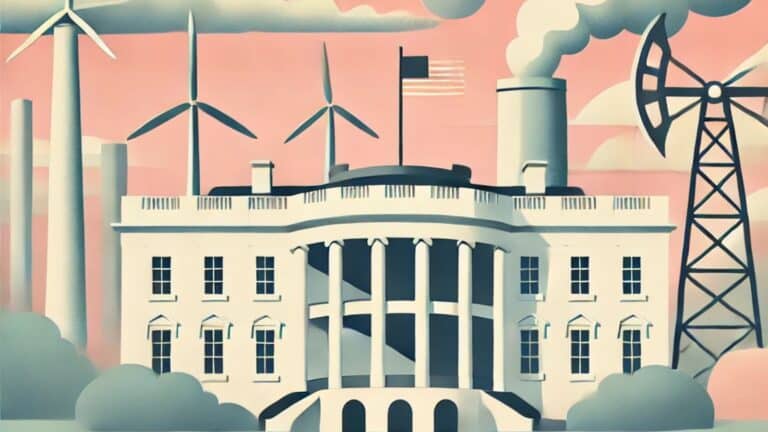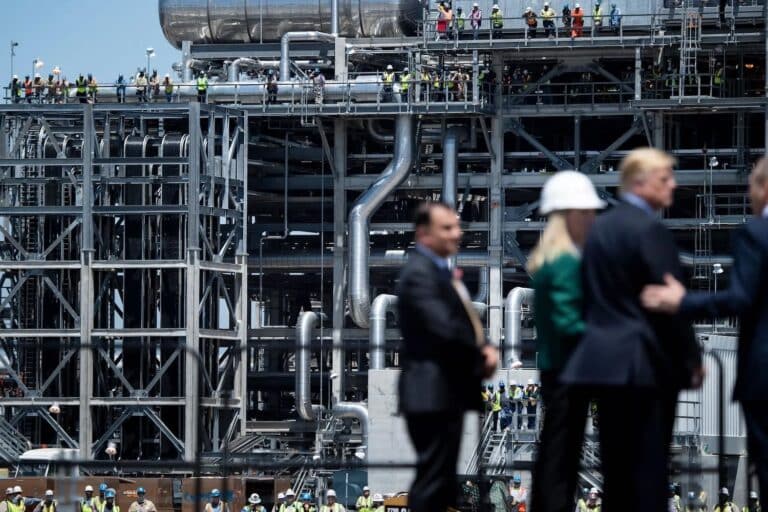The white-paper below was prepared by Jason Bordoff, Founding Director of the Center on Global Energy Policy and Professor of Professional Practice at Columbia University’s School of International and Public Affairs at the request of a September 2024 public policy forum in Washington, DC.
Some policy recommendations below further expand upon Jason Bordoff’s contribution to Foreign Policy’s September 9, 2024 series, “Letters to the Next President”, offering advice to the next U.S. President regardless of the outcome of U.S. elections in 2024.
The urgency of combatting the escalating threats of climate change is increasingly evident to anyone walking the streets of Phoenix in the summer, fighting wildfires in Canada, buying flood insurance in southern Florida, farming rice in Vietnam, or laboring outdoors in Pakistan. This year will almost certainly surpass 2023 as the warmest year on record, as climate record after climate record continues to be smashed.
On one hand, efforts to accelerate the pace of transition to a low-carbon energy system are yielding remarkable results. In the last decade, battery and solar costs have each fallen 90 percent and 80 percent, respectively. This year, global spending on clean energy is on track to reach almost double the amount going to fossil fuels. Solar and wind are set to meet as much as three-quarters of the expected growth in global electricity demand this year and next.
Despite all this progress, however, oil use, natural gas use, and coal use are all still rising globally, and annual global greenhouse gas emissions will reach their highest level ever in 2024. That is because the scale of the global energy system remains so vast that the tremendous growth in low-carbon energy sources is able to meet most of the increase in energy use that results from economic and population growth, but clean energy is not yet scaling fast enough to significantly replace hydrocarbons and thus drive emissions to net-zero. In other words, the world today is in the midst of a clean energy addition, but not yet a much-needed transition.
Acknowledging this hard reality, a top priority for a Harris administration should thus be dramatically accelerating the deployment of low-carbon energy globally at a pace and scale sufficient to actually begin “transitioning away from fossil fuels” by making oil, gas and coal use fall, as countries pledged to do at last year’s UN climate conference.
The Inflation Reduction Act was a historic step toward this goal, representing the world’s largest-ever investment in clean energy. To realize its full potential, the Harris administration should move quickly to finalize outstanding regulatory guidance to allow companies to access federal incentives, provide the market with certainty that long-term tax incentives for clean energy deployment will remain in place, and make it easier to build energy infrastructure at scale by working with Congress to enact meaningful permitting reform, building on the current proposal by Senators Barrasso and Manchin.
Yet while successful implementation of the IRA (along with regulatory actions to control emissions from power plants, cars and trucks, and oil and gas production) are all necessary to get the United States closer to its goal of reducing emissions at least 50 percent by 2030 (compared to 2005), the U.S. represents less than 5 percent of future greenhouse gas emissions through the end of the century. Emissions are growing fastest in emerging and developing economies, which already comprise two-thirds of global greenhouse gas emissions. There are roughly two dozen emerging economies across the globe that are poised to sharply increase their greenhouse emissions in the next two decades by even more than the 200 billion metric tons China spewed in the first two decades of the 21st century. If they do so, it will be virtually impossible to achieve the goal of keeping global temperature rise well below two degrees Celsius.
The Harris administration should thus build on the success of the IRA with an even more ambitious policy agenda to accelerate clean energy deployment in the rest of the world. And just as the IRA’s success required breaking with traditional conceptions of climate policy, so too must international climate action.
The predominant approaches to climate policy design for decades were premised on the view that there is a large cost to switching to clean energy, and the best way to minimize that cost would be to make people and firms pay for the harms their emissions caused–through instruments such as a carbon tax or cap-and-trade system. The Inflation Reduction Act departed from this climate policy orthodoxy by recognizing that (1) subsidies are more politically achievable; (2) government spending can start a flywheel of innovation and deployment that speeds up the pace of private investment in clean energy technologies by lowering their costs; and (3) failure to develop robust clean energy supply chains could be even more costly by allowing China to control rapidly growing clean energy markets.
In a similar way, the Harris administration should rethink some of the basic assumptions that have underpinned international climate policy for the past three decades since the first UN climate conference was held in 1995. The rationale for today’s international climate diplomacy architecture was that reducing emissions is costly, and–because every ton of emissions contributes equally to the global problem of climate change–there is an incentive for countries to “free ride” on the actions of others to curb emissions since the benefits of doing so accrue to all nations. A global structure to negotiate agreements about how much each country will reduce emissions thus helps ensure countries bear the costs of climate action together.
Yet not only has putting UN climate diplomacy at the center of global efforts to curb emissions failed to yield the desired results after three decades, the assumptions about burden-sharing and free-riding that explained the system’s original architecture no longer suffice. If harnessed properly, competition can be an even more powerful driver of climate action than cooperation. The Harris administration should prioritize dramatically increasing clean energy use in the rest of the world not just because the U.S. is the largest historic emitter or because mitigating climate risks requires collection action, but because doing so advances America’s self-interest, security, geostrategic influence, and economic competitiveness.
First, in a new era of great power competition, U.S. leadership in clean energy technologies enhances the country’s geostrategic position. China’s dominance in certain clean energy technologies— such as batteries and the cobalt, lithium, graphite, and other critical minerals needed for clean energy products—threatens America’s economic competitiveness and the resilience of its energy supply chains. China’s overcapacity in manufacturing relative to current and future demand undermines investments in the United States and other countries and distorts demand signals that allow the most innovative and efficient firms to compete in the global market. Avoiding a second “China Shock” to American manufacturing sectors, such as automotive, is particularly important as it becomes increasingly clear that China plans to respond to its own economic slowdown by subsidizing domestic manufacturing for export markets.
Second, expanding clean energy sectors in the rest of the world is in America’s national interest because doing so creates economic opportunities for U.S. firms, diversifies global energy supply chains away from China, and enhances U.S. soft power in rapidly growing economies. (In much the same way, the Marshall Plan not only rebuilt a war-ravaged Europe but also advanced U.S. economic interests, countered Soviet influence, and helped U.S. businesses.)
Third, driving emissions down faster in the rest of the world is important because emissions contribute to climate change everywhere, and the increasingly severe impacts of climate change globally pose national security risks to the United States. For example, climate-induced stresses lead to instability and large-scale population movements; key strategic regions risk conflict, fragility and instability, such as heat and drought in the Middle East and Sahel or sea-level rise in low-lying Indo-Pacific islands; and a rapidly warming Arctic has implications for military activity and resource competition in the region.
To increase the supply of clean energy products in emerging and developing economies and thus diversify supply chains and counter China’s influence in these markets, the Harris administration should prioritize three policy actions related to finance and trade.
First, the U.S. International Development Finance Corp. (DFC) can be a powerful tool to support U.S. investment overseas, such as in African or Latin American projects to mine, refine, and process critical minerals needed for clean energy products. As DFC comes up for reauthorization next year, the administration should work with Congress to provide DFC with more resources and also change the way federal budgeting rules account for equity investments; this would allow DFC to make far more equity investments even with its existing funding. The administration can also use DFC to encourage private investment in energy projects in emerging and developing economies by reducing the risk investors face from fluctuations in local currency that can significantly limit their returns or discourage their investment from the start. The U.S. Export-Import Bank is another tool to support the export of U.S. clean tech by providing financing for U.S. goods and services competing with foreign firms abroad. And the Harris administration should use its leverage with the multilateral development banks, notably the World Bank, to facilitate reforms that improve those institutions’ lending practices for clean energy.
While all these tools can be bolstered, their collective impact can be most strengthened by bringing them together in a more ambitious new framework that not only allocates more funding but also allows capital to be deployed more flexibly and creatively. Given the economic competitiveness and security imperatives, the Harris administration should work with both sides of the aisle on Capitol Hill to capitalize such an effort.
Second, contrary to today’s protectionist trends, the Harris administration should expand economic cooperation and trade partnerships with a vast number of other nations. Given the regulatory and permitting barriers to building clean energy projects domestically, and the many years it will take to diminish China’s lead in critical mineral supply, electric vehicles, battery manufacturing, and solar manufacturing, the best antidote to concerns about China’s clean technology dominance is more trade, not less.
Third, the Harris administration should work with Congress to counteract the unfair competitive advantage that nations such as China receive by manufacturing industrial products with higher greenhouse gas emissions. Such a carbon import tariff, as proposed with bipartisan support, should be paired with a domestic carbon fee to harmonize the policy with that of other nations—particularly the European Union’s planned carbon border adjustment mechanism. Countries that fall below certain emissions thresholds would be exempt from the carbon tariff. Such an approach can leverage the attractiveness of the U.S. market to incentivize emerging market countries to reduce their emissions, supported by complementary measures to reduce investment barriers and expand their access to clean energy finance. Indeed, many such nations, such as Brazil, India, Thailand, and Vietnam, are already seeking to protect their domestic products from unfair Chinese competition in clean energy products. The Harris administration should also not give up on the World Trade Organization as a forum to resolve trade disputes and work to reform the institution to encourage trade in clean technologies and low-carbon goods and ensure all countries benefit from the green transition.
In addition to these specific policy steps, the Harris administration should also restructure how international climate policy making is organized and led in the federal government. Given the prioritization for decades of international negotiation through the UN framework, it made sense for the administration’s point person on international climate policy to be the nation’s climate diplomat, leading a team housed at the Department of State. With today’s increased focus on economic competitiveness, national security, and industrial strategy, however, a more centralized structure is needed within the White House to coordinate all federal government tools–including not only UN climate negotiations but also international economics, defense, trade, development finance, export credit, and humanitarian assistance–to support more rapid deployment of clean energy in emerging and developing economies consistent with U.S. national interests.
To elevate and integrate these issues into other foreign policy priorities, the Harris administration should create a new Deputy National Security Advisor for Climate Change and Energy Transition to sit within the National Security Council. This person would ensure these issues are more regularly coordinated across agencies such as Commerce, Energy, State, Defense Treasury, USAID, DFC and others, included in the agendas of Principals’ Committee meetings (as appropriate), highlighted in the President’s Daily Briefing, and integrated into the President’s international engagements and into multilateral and bilateral diplomacy. To achieve maximum policy impact and coordination across domestic and international climate policy efforts, the Harris administration should also appoint a National Climate Advisor who reports directly to the president, with a DNSA for Climate Change and Energy Transition reporting both to that individual and to the National Security Advisor.
Despite this country’s deep divisions and polarization, the Harris administration should prioritize bringing people together from both parties to agree that diversifying clean energy supplies and accelerating deployment of clean energy in a very broad range of partner countries around the world is in America’s economic and security interests.





